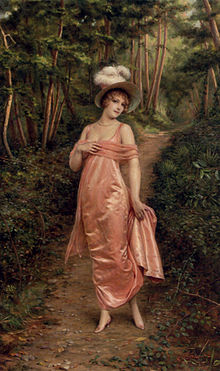- Elegance
-
"Elegant" redirects here. For the American novelist, see Robert Elegant.
 An example of "beauty in method"—a simple and elegant proof of the Pythagorean theorem.
An example of "beauty in method"—a simple and elegant proof of the Pythagorean theorem.
Elegance is a synonym for beauty that has come to acquire the additional connotations of unusual effectiveness and simplicity. It is frequently used as a standard of tastefulness particularly in the areas of visual design, decoration, the sciences, and the esthetics of mathematics. Elegant things exhibit refined grace and dignified propriety.
Contents
General concept
If it is difficult to define elegance elegantly, it is impossible to define it cogently[says who?] because the concept is vaguely and arbitrarily understood. Different applications of the term are not fully isomorphic in the sense described by Douglas Hofstadter as follows: “The word ‘isomorphism’ applies when two complex structures can be mapped onto each other, in such a way that to each part of one structure there is a corresponding part in the other structure, where ‘corresponding’ means that the two parts play similar roles in their respective structures.”[1] The lack of such an isomorphism means that various definitions are in some degree mutually inconsistent.
Nonetheless, essential components of the concept include simplicity and consistency of design, focusing on the essential features of an object. In art of any kind one might also require dignified grace, or restrained beauty of style.
Visual stimuli are frequently considered elegant if a small number of colors and stimuli are used, emphasizing the remainder.
In mathematics
The proof of a mathematical theorem exhibits mathematical elegance if it is surprisingly simple yet effective and constructive; similarly, a computer program or algorithm is elegant if it uses a small amount of code to great effect.[2][3]
In engineering
In engineering, a solution may be considered elegant if it uses a non-obvious method to produce a solution which is highly effective and simple. An elegant solution may solve multiple problems at once, especially problems not thought to be inter-related.[4]
In chemistry
In chemistry, chemists might look for elegance in theory and method, in technique and procedure. For example elegance might comprise creative parsimony and versatility in utilisation of resources, in manipulation of materials, and effectiveness in syntheses and analysis.
In pharmacy
In pharmacy, elegance in formulation is important for quality as well as effectiveness in dosage form design, a major component of pharmaceutics.
References
- ^ Hofstadter, Douglas R. (1999). Gödel, Escher, Bach: An Eternal Golden Braid. New York: Basic Books. ISBN 0-465-02656-7. OCLC 40724766.
- ^ Perrin, Chad (16 August 2006). "ITLOG Import: Elegance". Chad Perrin: SOB. http://sob.apotheon.org/?p=113.
- ^ Spolsky, Joel (15 December 2006). "Elegance". Joel on Software. http://www.joelonsoftware.com/items/2006/12/15.html.
- ^ Zeldes, Nathan (2007). "Ingenious simplicity". Nathan's Possibly Interesting Web Site. http://www.nzeldes.com/Miscellany/Elegance.htm. Retrieved 11 October 2011.
Further reading
- Schiro, Anne-Marie (30 August 1988). "For Galanos, Elegance Is Eternal". The New York Times. http://www.nytimes.com/1988/08/30/style/fashion-for-galanos-elegance-is-eternal.html.
Categories:- Concepts in aesthetics
- Science stubs
- Fashion stubs
Wikimedia Foundation. 2010.

